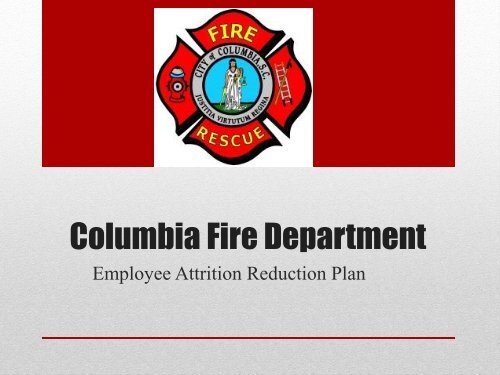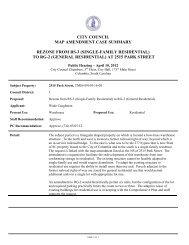Fire Department Attrition Reduction Plan Update - City of Columbia
Fire Department Attrition Reduction Plan Update - City of Columbia
Fire Department Attrition Reduction Plan Update - City of Columbia
You also want an ePaper? Increase the reach of your titles
YUMPU automatically turns print PDFs into web optimized ePapers that Google loves.
<strong>Columbia</strong> <strong>Fire</strong> <strong>Department</strong><br />
Employee <strong>Attrition</strong> <strong>Reduction</strong> <strong>Plan</strong>
<strong>Columbia</strong> <strong>Fire</strong> <strong>Department</strong> must<br />
establish a competitive marketplace<br />
necessary to retain a fully experienced<br />
and capable fire employee whose<br />
performance consistently meets or<br />
exceeds the <strong>City</strong>'s expectations.<br />
Reasonably Acceptable <strong>Attrition</strong><br />
<strong>City</strong> <strong>of</strong> <strong>Columbia</strong>; Office <strong>of</strong> the <strong>Fire</strong> Chief
Nationally recognized for its survey research services, the Institute monitors<br />
the quality <strong>of</strong> life in South Carolina by providing information to policy<br />
makers, the media, and the public. The Institute has the capacity to conduct<br />
all phases <strong>of</strong> survey research, including identification <strong>of</strong> the most appropriate<br />
method for gathering information, questionnaire design, sample selection,<br />
data collection and processing, and analysis. It conducts face-to-face,<br />
telephone, mail, and Internet surveys, as well as mixed-mode applications.<br />
Government managers and administrators frequently call the Institute to<br />
conduct independent analyses on a wide range <strong>of</strong> public policy and<br />
operational issues. Recent studies include analyses <strong>of</strong> procurement policies,<br />
organizational structure, business license ordinances, and department staffing<br />
and compensation levels. The Institute also has experience in process<br />
mapping and redesign, conducting training needs analyses, developing<br />
performance appraisal systems, and reviewing user fees and cost allocation.<br />
USC’s Institute for Public Safety and Policy Research<br />
<strong>City</strong> <strong>of</strong> <strong>Columbia</strong>; Office <strong>of</strong> the <strong>Fire</strong> Chief
USC’s Comprehensive Study was conducted in 3 phases.<br />
• Phase One: Previous Employee Survey Report<br />
• Phase Two: Current Employee Survey Report<br />
• Phase Three: Consisted <strong>of</strong> Human Resources Practices<br />
USC’s Institute for Public Safety and Policy Research<br />
<strong>City</strong> <strong>of</strong> <strong>Columbia</strong>; Office <strong>of</strong> the <strong>Fire</strong> Chief
Phase One and Phase Two:<br />
A previous Employee Survey Report was conducted to<br />
identify reasons former employees resigned or retired, and<br />
to gather data on both current and previous employee’s<br />
beliefs and attitudes about the <strong>Columbia</strong> <strong>Fire</strong> <strong>Department</strong>.<br />
Concurrently, active employees were confidentially<br />
surveyed in regards to factors related to turnover and<br />
retention including compensation, training, job satisfaction,<br />
and management practices.<br />
USC’s Institute for Public Safety and Policy Research<br />
<strong>City</strong> <strong>of</strong> <strong>Columbia</strong>; Office <strong>of</strong> the <strong>Fire</strong> Chief
• Employee Satisfaction Issues<br />
• Deficient Competitive Market Rate Compensation across all<br />
fire ranks<br />
• Lack <strong>of</strong> Comparable Annual FLSA working hours<br />
• Lack <strong>of</strong> incentives for required specialized training<br />
• High-performing employees not rewarded<br />
• Lack <strong>of</strong> retention / longevity incentives<br />
Issues Affecting <strong>Attrition</strong><br />
<strong>City</strong> <strong>of</strong> <strong>Columbia</strong>; Office <strong>of</strong> the <strong>Fire</strong> Chief
• 44% <strong>of</strong> former CFD employees would not<br />
recommend CFD as good place to work<br />
• Nearly 1/3 <strong>of</strong> all current CFD employees are<br />
dissatisfied with job<br />
• Comparatively 85% <strong>of</strong> employees in surveyed<br />
departments would recommend their department as<br />
a good place to work<br />
Employee Survey Report<br />
<strong>City</strong> <strong>of</strong> <strong>Columbia</strong>; Office <strong>of</strong> the <strong>Fire</strong> Chief
• Communication<br />
• Development <strong>of</strong> guidelines<br />
• Officer development<br />
• Employee recognition<br />
• Respect from command staff and managers<br />
• Command staff must admit mistakes<br />
• Seek employee input on new ideas and improvements<br />
• Improved use <strong>of</strong> resources<br />
Improving Employee Satisfaction<br />
<strong>City</strong> <strong>of</strong> <strong>Columbia</strong>; Office <strong>of</strong> the <strong>Fire</strong> Chief
Phase Three <strong>of</strong> the study surveyed Human<br />
Resources Practices for 21 metropolitan fire<br />
departments in the southeastern US<br />
9 departments responded consisting <strong>of</strong> 115 to 820<br />
employees, with an average size <strong>of</strong> 415<br />
5 departments <strong>of</strong>fered paramedic service and 2<br />
<strong>of</strong>fered EMT services; 2 <strong>of</strong>fered no medical<br />
services<br />
USC’s Institute for Public Safety and Policy Research<br />
<strong>City</strong> <strong>of</strong> <strong>Columbia</strong>; Office <strong>of</strong> the <strong>Fire</strong> Chief
• Lowest Salaried Respondent reported 20% <strong>Attrition</strong> Rate<br />
• Second Lowest Salaried Respondents reported 8% <strong>Attrition</strong> Rate<br />
• Upper-half Salaried Respondents reported less than 3% <strong>Attrition</strong> Rate<br />
• CFD 2011 <strong>Attrition</strong> Rate 13.29% (55 /414)<br />
• 89% <strong>of</strong> CFD personnel dissatisfied with pay<br />
• Many 6-month to 1-year firefighters now earning more than 4 year<br />
employees due to lack <strong>of</strong> adjustments<br />
• There are firefighters currently qualified for and receiving<br />
food stamps<br />
Respondent <strong>Attrition</strong> Comparison<br />
<strong>City</strong> <strong>of</strong> <strong>Columbia</strong>; Office <strong>of</strong> the <strong>Fire</strong> Chief
• CFD 6 Year Average <strong>Attrition</strong> Rate is currently 9.3%<br />
• CFD has lost a total <strong>of</strong> 251 personnel between 2006-2012*<br />
• 90 personnel since January 2011 alone<br />
• CFD has replaced 60% <strong>of</strong> department since 2006.<br />
• CFD average salaries rank below all respondents' reported<br />
minimum salaries<br />
• 2012* attrition rate is 8.45% (35 / 414)<br />
• 185 personnel have less than 5 years <strong>of</strong> service currently<br />
earning entry level pay.<br />
CFD <strong>Attrition</strong> Rate 2006-2012<br />
<strong>City</strong> <strong>of</strong> <strong>Columbia</strong>; Office <strong>of</strong> the <strong>Fire</strong> Chief
Annual Compensation<br />
$70,000<br />
$60,000<br />
$50,000<br />
$40,000<br />
$30,000<br />
$20,000<br />
$10,000<br />
$-<br />
<strong>Fire</strong><br />
Battalion Division<br />
Engineer Captain<br />
Fighter<br />
Chief Chief<br />
CFD Starting $28,919 $32,001 $42,790 $47,414 $50,497<br />
Market Rate $37,554 $39,291 $52,876 $64,793 $65,486<br />
% Difference -29.86% -41% -23.57% -36.65% -29.68%<br />
Market Rate Starting Salary Disparity<br />
<strong>City</strong> <strong>of</strong> <strong>Columbia</strong>; Office <strong>of</strong> the <strong>Fire</strong> Chief
Annual Compensation<br />
$90,000<br />
$80,000<br />
$70,000<br />
$60,000<br />
$50,000<br />
$40,000<br />
$30,000<br />
$20,000<br />
$10,000<br />
$-<br />
<strong>Fire</strong><br />
Fighter<br />
<strong>Fire</strong><br />
Engineer<br />
<strong>Fire</strong><br />
Captain<br />
Battalion<br />
Chief<br />
Division<br />
Chief<br />
COC Median $30,641 $38,813 $47,714 $57,691 $68,015<br />
COC Avg $31,316 $41,285 $48,725 $58,661 $67,322<br />
Study Avg. $46,845 $58,053 $65,895 $81,777 $81,040<br />
Market Rate Actual Salary Disparity<br />
<strong>City</strong> <strong>of</strong> <strong>Columbia</strong>; Office <strong>of</strong> the <strong>Fire</strong> Chief
Surveyed <strong>City</strong> USC CREC*<br />
• Nashville 5.0% 5.1% lower than <strong>Columbia</strong><br />
• Tampa<br />
3.5% 2.4% lower than <strong>Columbia</strong><br />
• Rock Hill 3.2% ------ lower than <strong>Columbia</strong><br />
• Charlotte 2.1% 0.6% lower than <strong>Columbia</strong><br />
• Raleigh 1.4% 2.9% lower than <strong>Columbia</strong><br />
• Orlando<br />
• Charleston<br />
• Gainesville<br />
2.8% 3.1% higher than <strong>Columbia</strong><br />
4.4% 4.4% higher than <strong>Columbia</strong><br />
5.4% 4.6% higher than <strong>Columbia</strong><br />
Cost-<strong>of</strong>-Living Index Comparisons<br />
<strong>City</strong> <strong>of</strong> <strong>Columbia</strong>; Office <strong>of</strong> the <strong>Fire</strong> Chief<br />
*Center for Regional Economic Competitiveness
• $1.89 million spent in 2012 for latest 44 newly hired<br />
firefighters for their first full year <strong>of</strong> employment<br />
• Pre-Employment Testing, Recruit Training, Benefits,<br />
Equipment, and Salary<br />
• $990,000 spent in 2011 for recruit training<br />
• $630,000 spent in 2012 for recruit training<br />
• Currently 42 fire suppression positions open<br />
• Projected costs are $756,000 to train and equip them<br />
First Year Investment Cost <strong>of</strong> New Personnel<br />
<strong>City</strong> <strong>of</strong> <strong>Columbia</strong>; Office <strong>of</strong> the <strong>Fire</strong> Chief
70<br />
60<br />
50<br />
40<br />
30<br />
20<br />
10<br />
Recruits<br />
Separations<br />
Net Loss<br />
/Gain<br />
0<br />
-10<br />
2006 2007 2008 2009 2010 2011 2012<br />
-20<br />
<strong>Fire</strong> Employee Net Loss/Gain<br />
<strong>City</strong> <strong>of</strong> <strong>Columbia</strong>; Office <strong>of</strong> the <strong>Fire</strong> Chief
•A/C <strong>of</strong> Pr<strong>of</strong>essional Services was advised that possibly 15<br />
CFD firefighters have applied for Lexington County <strong>Fire</strong><br />
Service openings<br />
• It would cost upwards <strong>of</strong> $270,000 to replace these 15<br />
firefighters<br />
• Cost does not include required specialized training,<br />
promotional costs, hiring costs or training requirements<br />
• Current CFD <strong>Fire</strong> Engineers can leave and earn a<br />
higher starting salary as a firefighter at LCFS; two<br />
ranks below their current position.<br />
True Cost <strong>of</strong> <strong>Attrition</strong><br />
<strong>City</strong> <strong>of</strong> <strong>Columbia</strong>; Office <strong>of</strong> the <strong>Fire</strong> Chief
• $3.33 Million spent on new hires over last 5 years<br />
• CFD’s 5 year average attrition rate <strong>of</strong> 9.3%<br />
cost $666,000 per year to replace<br />
• Attaining a 3% Target Annual <strong>Attrition</strong> Rate <strong>of</strong> 12<br />
employees would have a projected cost <strong>of</strong> $192,000<br />
• 71% annual reduction <strong>of</strong> new employee training costs<br />
• 2002 attrition rate was 2.6% w/ only 10 departures<br />
3% Target <strong>Attrition</strong> Rate Savings<br />
<strong>City</strong> <strong>of</strong> <strong>Columbia</strong>; Office <strong>of</strong> the <strong>Fire</strong> Chief
$1,200,000.00<br />
2006-2012* <strong>Attrition</strong> Cost<br />
$1,000,000.00<br />
$800,000.00<br />
$600,000.00<br />
$400,000.00<br />
$200,000.00<br />
$-<br />
2006 2007 2008 2009 2010 2011 2012* 3%<br />
Target<br />
3% <strong>Attrition</strong> Rate Savings<br />
<strong>City</strong> <strong>of</strong> <strong>Columbia</strong>; Office <strong>of</strong> the <strong>Fire</strong> Chief
Attaining a 3% attrition rate will result in immediate new<br />
hire cost reductions<br />
•$798,000 reduction in recruit costs from 2011<br />
•$438,000 reduction in recruit costs from 2012<br />
•$2.37 Million reduction in recruit costs for next 5 years<br />
for attaining 3% attrition rate, replacing 12 per year<br />
We must protect our most valuable resource by<br />
investing in and retaining experienced personnel<br />
Target <strong>Attrition</strong> Rate Savings<br />
<strong>City</strong> <strong>of</strong> <strong>Columbia</strong>; Office <strong>of</strong> the <strong>Fire</strong> Chief
Salary ranges have an established minimum, mid-point, and<br />
maximum salary.<br />
•Minimum salary <strong>of</strong> the a salary range represents the minimum<br />
salary that an organization pays for an individual whose<br />
combination <strong>of</strong> related prior education, training and experience<br />
meets the minimum qualification requirements as specified in the<br />
<strong>City</strong>’s approved job description.<br />
•Mid-Point salary <strong>of</strong> a salary range represents a marketplace<br />
competitive salary necessary to retain a fully experienced and<br />
capable employee whose performance is consistently meeting the<br />
<strong>City</strong>'s expectations.*<br />
•Maximum salary <strong>of</strong> the salary range represents the maximum<br />
salary that the position is valued to the <strong>City</strong>.<br />
ESTABLISHED SALARY RANGES<br />
<strong>City</strong> <strong>of</strong> <strong>Columbia</strong>; Office <strong>of</strong> the <strong>Fire</strong> Chief<br />
*<strong>City</strong> <strong>of</strong> <strong>Columbia</strong> Personnel Policy Manual, Pg.1
90% <strong>of</strong> CFD <strong>Fire</strong> Employees agreed that high<br />
performance was NOT recognized or rewarded<br />
Examples <strong>of</strong> Performance Compensation:<br />
• Education / Degrees<br />
• Second Language<br />
• Rescue / Hazmat Support<br />
• Specialized Technical Rescue/ Hazmat Specialist<br />
• Advanced <strong>Fire</strong> Marshal Certifications<br />
• Emergency Medical Technician<br />
Qualified Certification Performance<br />
<strong>City</strong> <strong>of</strong> <strong>Columbia</strong>; Office <strong>of</strong> the <strong>Fire</strong> Chief
Hourly rates<br />
• <strong>Fire</strong> Flow technician earns $13.16/hr<br />
• Minimal on the job training for productive performance<br />
• This position works 80 hrs/pay period<br />
• This position works 2080 hrs/year<br />
• Administration assistant earns $13.42/hr<br />
• Minimal on the job training for productive performance<br />
• This position works 80 hrs/pay period<br />
• This position works 2080 hrs/year<br />
<strong>City</strong> <strong>of</strong> <strong>Columbia</strong> Hourly Wage Comparison<br />
<strong>City</strong> <strong>of</strong> <strong>Columbia</strong>; Office <strong>of</strong> the <strong>Fire</strong> Chief
Certified police <strong>of</strong>ficer earns $14.24 / hr<br />
• 15 weeks <strong>of</strong> training before being able to work<br />
independently<br />
• Police <strong>of</strong>ficers work 85 hours / pay period<br />
• Police <strong>of</strong>ficers work 2184 hrs / year<br />
•Certified firefighter earns $10.50 / hr<br />
• 16 weeks <strong>of</strong> training before being able to work<br />
independently<br />
• Pay calculated on FLSA 106 hour bi-weekly schedule<br />
• FLSA <strong>of</strong> 2756 annual hours calculated<br />
• <strong>Fire</strong>fighters are actually scheduled to work 2920 hours per<br />
year. (365 Days x 24 hours ÷ 3 = 2920)<br />
<strong>City</strong> <strong>of</strong> <strong>Columbia</strong> Hourly Wage Comparison<br />
<strong>City</strong> <strong>of</strong> <strong>Columbia</strong>; Office <strong>of</strong> the <strong>Fire</strong> Chief
• In 2008, The Public Safety Retention <strong>Plan</strong> consisting <strong>of</strong><br />
a 10% market adjustment was initiated as unanimously<br />
approved by <strong>City</strong> Council to be implemented over 3<br />
years for the Retention and Recruitment <strong>of</strong> Public<br />
Safety Personnel<br />
• Only the first phase <strong>of</strong> 3.37% was given<br />
• An independent fire department compensation study in<br />
2007 showed an 18% market rate disparity in which<br />
the council approved adjustments were based<br />
2008 Public Safety Recruitment<br />
<strong>City</strong> <strong>of</strong> <strong>Columbia</strong>; Office <strong>of</strong> the <strong>Fire</strong> Chief<br />
and Retention <strong>Plan</strong>
• Employees scheduled to work 8 hours per day/5 days per week<br />
or 2080 hours during the calendar year, will receive holiday<br />
leave hours at the rate <strong>of</strong> 8 hours per holiday.<br />
• 100% scheduled Shift hours received per holiday<br />
• Police Employees scheduled to work 12-hour shifts, or 2210<br />
hours during the calendar year, will receive holiday leave<br />
hours at the rate <strong>of</strong> 8.5 hours per holiday.<br />
• 71% scheduled Shift hours received per holiday<br />
• <strong>Fire</strong> Employees scheduled to work 24-hour shifts, or 2756<br />
hours during the calendar year, will receive holiday leave<br />
hours at the rate <strong>of</strong> 12.0 hours per holiday.<br />
• 50% scheduled Shift hours received per holiday<br />
Public Safety Benefit Parity<br />
<strong>City</strong> <strong>of</strong> <strong>Columbia</strong>; Office <strong>of</strong> the <strong>Fire</strong> Chief
100%<br />
75%<br />
50%<br />
25%<br />
8 HOUR<br />
POLICE<br />
FIRE<br />
0%<br />
% <strong>of</strong> Holiday Hours Recevied<br />
Public Safety Benefit Parity<br />
<strong>City</strong> <strong>of</strong> <strong>Columbia</strong>; Office <strong>of</strong> the <strong>Fire</strong> Chief
Surveyed departments reported:<br />
• Annual work hours between 2,374 to 2,920<br />
• Average Annual hours worked <strong>of</strong> 2,620 per year<br />
• Annual Leave Range <strong>of</strong> 360 to 522 hours<br />
• Average annual leave <strong>of</strong> 425 hours<br />
• Average <strong>of</strong> 1 to 2 “Kelly Days” per month.<br />
• Kelly Days reduce FLSA hours actually worked<br />
Respondent Annual Hours Worked<br />
<strong>City</strong> <strong>of</strong> <strong>Columbia</strong>; Office <strong>of</strong> the <strong>Fire</strong> Chief
600<br />
500<br />
400<br />
300<br />
CFD Annual<br />
Hours<br />
Respondent<br />
Hours<br />
200<br />
100<br />
0<br />
Min-Leave Mid-Range Max-Leave<br />
Comparative Permissive Leave Hours<br />
<strong>City</strong> <strong>of</strong> <strong>Columbia</strong>; Office <strong>of</strong> the <strong>Fire</strong> Chief
24 Hour <strong>Fire</strong> Shift employees work 2,920 hours per year<br />
• 120 Holiday Hours<br />
• 111 Hours Annual 1-5 Years = 231 total hours <strong>of</strong> leave<br />
• 169 Hours Annual 10 Years = 289 total hours <strong>of</strong> leave<br />
• 282 Hours Annual 19+ Years = 402 total hours <strong>of</strong> leave<br />
• 10 Year <strong>Fire</strong> Employees receive 32% less permissive<br />
leave than that <strong>of</strong> the respondent average<br />
• 20 Year <strong>Fire</strong> Employees receive 23 hours less total<br />
permissive than the respondent average<br />
CFD’s Comparable Total Permissive Leave<br />
<strong>City</strong> <strong>of</strong> <strong>Columbia</strong>; Office <strong>of</strong> the <strong>Fire</strong> Chief
PAY CLASS<br />
CALENDAR<br />
FYI ONLY<br />
DEFAULT<br />
PATCHED<br />
HRS (Set in<br />
IFAS)<br />
(HREMEN)<br />
SCHEDULED<br />
BI-WEEKLY (HREMEN)FTE<br />
(HRQP)<br />
SCHEDULED<br />
HOURS/DAY<br />
(HRQP)<br />
DAYS/YR<br />
(HRQP)<br />
(PAY)<br />
PERIODS<br />
PRO-RATE<br />
YES=Check Mark<br />
NO= Leave Blank<br />
RE-CALC CD<br />
130<br />
FIRE SHIFT<br />
EXEMPT<br />
FLSA<br />
(106 hrs X 26)<br />
FIREA 96/120 96/120 1.0 24.0 114.83 26 NO P<br />
135<br />
FIRE SHIFT<br />
NON-<br />
EXEMPT<br />
FLSA<br />
(106 hrs X 26)<br />
FIREA 96/120 96/120 1.0 24.0 114.83 26 NO P<br />
Actual Days<br />
Scheduled<br />
(365÷3) 121.67<br />
Total Days<br />
Differential 6.84<br />
<strong>City</strong> <strong>Fire</strong> FLSA Calendar*<br />
<strong>City</strong> <strong>of</strong> <strong>Columbia</strong>; Office <strong>of</strong> the <strong>Fire</strong> Chief<br />
*PayClass-Calendar&Etc-As <strong>of</strong> 05(14)07-r03.xls
• Current vacant positions not attracting high performing employees due<br />
to lack <strong>of</strong> incentives and compensation<br />
• Lack <strong>of</strong> retention incentives not enticing experienced personnel to<br />
continue working after reaching retirement eligibility.<br />
• Only 4 <strong>Fire</strong> Suppression Personnel currently have 25 or more years <strong>of</strong><br />
service (Many are buying time to leave)<br />
• 41 fire suppression personnel eligible for retirement in 2.5 years / 2015<br />
• Each year thereafter large groups <strong>of</strong> hires will become eligible for<br />
retirement all at once<br />
Comparative Market Retention Policies<br />
<strong>City</strong> <strong>of</strong> <strong>Columbia</strong>; Office <strong>of</strong> the <strong>Fire</strong> Chief
• 11 Battalion Chiefs<br />
• 29 Captains<br />
• (15 Out <strong>of</strong> Class Personnel- moved up)<br />
• 71 <strong>Fire</strong> Engineers<br />
• (20 Out <strong>of</strong> Class Personnel- moved up)<br />
• 27 Senior <strong>Fire</strong>fighters<br />
• 92 <strong>Fire</strong>fighters<br />
1 Year <strong>of</strong> service or less in position<br />
<strong>City</strong> <strong>of</strong> <strong>Columbia</strong>; Office <strong>of</strong> the <strong>Fire</strong> Chief
• Current <strong>Fire</strong> Budget $20.54 million<br />
• $175.25 per capita for COC fire protection<br />
• ICMA South Atlantic Average<br />
• $201.00 per capita fire on average<br />
• ICMA South Atlantic Average comparable<br />
budget = $23.55 million (2008 funding levels)<br />
International <strong>City</strong>/County Management<br />
Association<br />
<strong>City</strong> <strong>of</strong> <strong>Columbia</strong>; Office <strong>of</strong> the <strong>Fire</strong> Chief
Report <strong>of</strong> Mayor-Elect Steve Benjamin’s Transition Team; Page 75, 81<br />
…It is clearly established in reports dating back close to a decade that the<br />
same problems and issues heard throughout the committee’s work are<br />
recurring...<br />
These chronic issues must be addressed to allow the city to move ahead in a<br />
constructive manner and allow for improved service delivery to the citizens<br />
<strong>of</strong> greater <strong>Columbia</strong>.<br />
TOP PRIORITIES (6-24 MONTHS)<br />
• Revisit previous compensation studies and update as necessary to make<br />
recommendations to address public safety sector recruiting, retention,<br />
and promotion opportunities<br />
Report <strong>of</strong> Mayor-Elect Steve Benjamin’s Transition Team<br />
June 30 th , 2010<br />
<strong>City</strong> <strong>of</strong> <strong>Columbia</strong>; Office <strong>of</strong> the <strong>Fire</strong> Chief
Report <strong>of</strong> Mayor-Elect Steve Benjamin’s Transition Team;<br />
Page 84<br />
<strong>Fire</strong> <strong>Department</strong>/Services and EMS<br />
• Substantial pay cuts for employees and services<br />
• Compensation Discrepancies<br />
• <strong>Fire</strong>fighters are working many hours that continue to<br />
increase annually, yet not fairly compensated<br />
• Outstanding tests, classes, and certification examinations<br />
attended and taken <strong>of</strong>f duty without pay<br />
• No funding for specialized training that is required by OSHA<br />
Report <strong>of</strong> Mayor-Elect Steve Benjamin’s Transition Team<br />
June 30 th , 2010<br />
<strong>City</strong> <strong>of</strong> <strong>Columbia</strong>; Office <strong>of</strong> the <strong>Fire</strong> Chief
Report <strong>of</strong> Mayor-Elect Steve Benjamin’s Transition Team; Page 85<br />
<strong>Attrition</strong><br />
• Cost over the 3 years - $1.75million<br />
• In the last 6 months the department has lost 20+ people<br />
• It costs an additional $400,000 to replace the last 20 people<br />
• Experienced loss <strong>of</strong> 65 firefighters<br />
• Availability <strong>of</strong> qualified personnel to fit leadership capacities are lacking<br />
• Losing best and brightest—remain for short period <strong>of</strong> time; then leave for<br />
greater opportunities in larger metropolitan areas (CLT, ATL)<br />
• Incentive Programs to retain and/or attract best people<br />
• Healthcare: Irmo <strong>Fire</strong> District has recently upgraded to provide fully<br />
paid healthcare for employee retention purposes<br />
Report <strong>of</strong> Mayor-Elect Steve Benjamin’s Transition Team<br />
June 30 th , 2010<br />
<strong>City</strong> <strong>of</strong> <strong>Columbia</strong>; Office <strong>of</strong> the <strong>Fire</strong> Chief
1. Fulfill 2007 Public Safety Retention <strong>Plan</strong> <strong>of</strong> 6.67%<br />
2. Market Rate Adjustment for all ranks<br />
a. Competitive Fair Market Value for fully<br />
experienced & consistently performing employees<br />
b. Address compression and overlap in each rank<br />
c. High-Performance Employee Compensation<br />
3. Adjustment <strong>of</strong> FLSA Work Schedule to 114.83 Days<br />
4. 170 Hour Holiday Benefit parity<br />
5. Longevity incentives for retention <strong>of</strong> experienced<br />
personnel<br />
Proposed <strong>Attrition</strong> Action Items<br />
<strong>City</strong> <strong>of</strong> <strong>Columbia</strong>; Office <strong>of</strong> the <strong>Fire</strong> Chief
Funding Sources<br />
<strong>City</strong> <strong>of</strong> <strong>Columbia</strong>; Office <strong>of</strong> the <strong>Fire</strong> Chief





